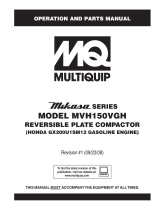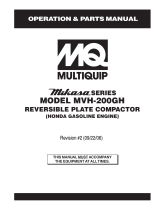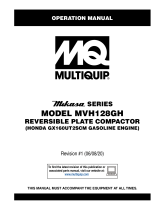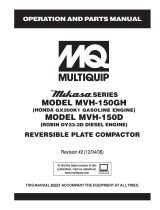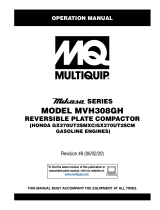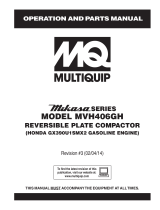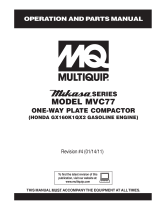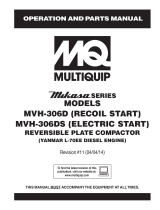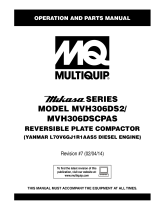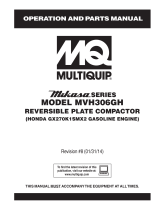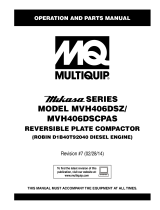Page is loading ...

THIS MANUAL MUST ACCOMPANY THE EQUIPMENT AT ALL TIMES.
To find the latest revision of this
publication, visit our website at:
www.multiquip.com
OPERATION AND PARTS MANUAL
SERIES
MODEL MVH120VGH
REVERSIBLE PLATE COMPACTOR
(HONDA GX160U1SMX4 GASOLINE ENGINE)
Revision #2 (09/22/08)

PAGE 2 — MVH120VGH PLATE COMPACTOR • OPERATION AND PARTS MANUAL — REV. #2 (09/22/08)
PROPOSITION 65 WARNING

MVH120VGH • OPERATION AND PARTS MANUAL — REV. #2 (09/22/08) — PAGE 3
NOTES

PAGE 4 — MVH120VGH PLATE COMPACTOR • OPERATION AND PARTS MANUAL — REV. #2 (09/22/08)
TABLE OF CONTENTS
MVH120VGH PLATE
COMPACTOR
Proposition 65 Warning ........................................... 2
Table of Contents .................................................... 4
Parts Ordering Procedures ..................................... 5
Safety Information ................................................ 6-9
Specifications ........................................................ 11
Dimensions ........................................................... 12
General Information .............................................. 13
Components.......................................................... 14
Basic Engine ......................................................... 15
Inspection ......................................................... 16-17
Operation ......................................................... 18-19
Maintenance .................................................... 20-22
Troubleshooting ............................................... 23-25
Explanation of Code in Remarks Column ............. 26
Suggested Spare Parts ......................................... 27
COMPONENT DRAWINGS
Nameplate and Decals..................................... 28-29
Vibrating Plate Assy. ........................................ 30-31
Body Assy. ........................................................ 32-33
Vibrator Assy. ................................................... 34-35
Control Assy. .................................................... 36-39
Hand Pump Assy. ............................................. 40-41
HONDA GX160U1SMX4
DRAWINGS
Cylinder Head Assy. ......................................... 42-43
Cylinder Barrel Assy. ........................................ 44-45
Crankcase Cover Assy. .................................... 46-47
Crankshaft Assy. .............................................. 48-49
Piston Assy. ...................................................... 50-51
Camshaft Assy. ................................................ 52-53
Recoil Starter Assy........................................... 54-55
Fan Cover Assy. ............................................... 56-57
Carburetor Assy. .............................................. 58-59
Air Cleaner Assy. .............................................. 60-61
Muffler Assy...................................................... 62-63
Fuel Tank Assy. ................................................ 64-65
Flywheel Assy................................................... 66-67
Ignition Assy. .................................................... 68-69
Control Assy. .................................................... 70-71
Label Assy. ....................................................... 72-73
Tools Assy. ....................................................... 74-75
Terms and Conditions of Sale — Parts ................. 76

MVH120VGH • OPERATION AND PARTS MANUAL — REV. #2 (09/22/08) — PAGE 5
PARTS ORDERING PROCEDURES
www.multiquip.com
Ordering parts has never been easier!
Choose from three easy options:
WE ACCEPT ALL MAJOR CREDIT CARDS!
When ordering parts, please supply:
❒❒
❒❒
❒
Dealer Account Number
❒❒
❒❒
❒
Dealer Name and Address
❒❒
❒❒
❒
Shipping Address (if different than billing address)
❒❒
❒❒
❒
Return Fax Number
❒❒
❒❒
❒
Applicable Model Number
❒❒
❒❒
❒
Quantity, Part Number and Description of Each Part
❒❒
❒❒
❒
Specify Preferred Method of Shipment:
✓
UPS/Fed Ex
✓ DHL
■
Priority One
✓
Tr u ck
■
Ground
■ Next Day
■
Second/Third Day
All orders are treated as
Standard Orders
and will ship the same day if received prior
to 3PM PST.
If you have an MQ Account, to obtain a
Username and Password, E-mail us at:
To obtain an MQ Account, contact your
District Sales Manager for more information.
Order via Internet (Dealers Only):
Order parts on-line using Multiquip’s SmartEquip website!
■
View Parts Diagrams
■
Order Parts
■
Print Specification Information
Note: Discounts Are Subject To Change
Goto www.multiquip.com and click on
Order Parts
to log in and save!
Use the
internet
and qualify for a 5% Discount
on
Standard orders
for all orders which include
complete part numbers.*
Order via Fax (Dealers Only):
All customers are welcome to order parts via Fax.
Domestic (US) Customers dial:
1-800-6-PARTS-7 (800-672-7877)
Fax
your order in and qualify for a 2% Discount
on
Standard orders
for all orders which include
complete part numbers.*
Order via Phone:
Domestic (US) Dealers Call:
1-800-427-1244
Best Deal!
International Customers
should contact
their local Multiquip Representatives for
Parts Ordering information.
Non-Dealer Customers:
Contact your local Multiquip Dealer for
parts or call 800-427-1244 for help in
locating a dealer near you.
Note: Discounts Are Subject To Change
Effective:
January 1
st
, 2006

PAGE 6 — MVH120VGH PLATE COMPACTOR • OPERATION AND PARTS MANUAL — REV. #2 (09/22/08)
SAFETY INFORMATION
Do not operate or service the equipment before reading
the entire manual. Safety precautions should be followed
at all times when operating this equipment.
Failure to readand understand the safety
messages and operating instructions could
result in injury to yourself and others.
SAFETY MESSAGES
The four safety messages shown below will inform you
about potential hazards that could injure you or others. The
safety messages specifically address the level of exposure
to the operator and are preceded by one of four words:
DANGER, WARNING, CAUTION or NOTICE.
SAFETY SYMBOLS
DANGER
Indicates a hazardous situation which, if not avoided,
WILL result in DEATH or SERIOUS INJURY.
WARNING
Indicates a hazardous situation which, if not avoided,
COULD result in DEATH or SERIOUS INJURY.
CAUTION
Indicates a hazardous situation which, if not avoided,
COULD result in MINOR or MODERATE INJURY.
NOTICE
Addresses practices not related to personal injury.
Potential hazards associated with the operation of this
equipment will be referenced with hazard symbols which
may appear throughout this manual in conjunction with
safety messages.

MVH120VGH • OPERATION AND PARTS MANUAL — REV. #2 (09/22/08) — PAGE 7
SAFETY INFORMATION
GENERAL SAFETY
CAUTION
NEVER operate this equipment without proper protective
clothing, shatterproof glasses, respiratory protection,
hearing protection, steel-toed boots and other protective
devices required by the job or city and state regulations.
NEVER operate this equipment when not
feeling well due to fatigue, illness or when
under medication.
NEVER operate this equipment under the influence of
drugs or alcohol.
NOTICE
This equipment should only be operated by trained and
qualified personnel 18 years of age and older.
Whenever necessary, replace nameplate, operation and
safety decals when they become difficult read.
Manufacturer does not assume responsibility for any
accident due to equipment modifications. Unauthorized
equipment modification will void all warranties.
NEVER use accessories or attachments that are not
recommended by Multiquip for this equipment. Damage
to the equipment and/or injury to user may result.
ALWAYS know the location of the nearest
fire extinguisher.
ALWAYS know the location of the nearest
first aid kit.
ALWAYS know the location of the nearest phone or keep
a phone on the job site. Also, know the phone numbers
of the nearest ambulance, doctor and fire department.
This information will be invaluable in the case of an
emergency.
COMPACTOR SAFETY
DANGER
The engine fuel exhaust gases contain poisonous carbon
monoxide. This gas is colorless and odorless, and can
cause death if inhaled.
The engine of this equipment requires an adequate free
flow of cooling air. NEVER operate this equipment in any
enclosed or narrow area
where free flow of the air is
restricted. If the air flow is
restricted it will cause injury
to people and property and
serious damage to the
equipment or engine.
NEVER operate the equipment in an explosive
atmosphere or near combustible materials. An
explosion or fire could result causing severe
bodily harm or even death.
WARNING
NEVER disconnect any emergency or safety devices.
These devices are intended for operator safety.
Disconnection of these devices can cause severe injury,
bodily harm or even death. Disconnection of any of these
devices will void all warranties.
CAUTION
NEVER lubricate components or attempt service on a
running machine.
NOTICE
ALWAYS keep the machine in proper running condition.
Fix damage to machine and replace any broken parts
immediately.
ALWAYS store equipment properly when it is not being
used. Equipment should be stored in a clean, dry location
out of the reach of children and unauthorized personnel.

PAGE 8 — MVH120VGH PLATE COMPACTOR • OPERATION AND PARTS MANUAL — REV. #2 (09/22/08)
SAFETY INFORMATION
ENGINE SAFETY
WARNING
DO NOT place hands or fingers inside engine
compartment when engine is running.
NEVER operate the engine with heat shields or
guards removed.
Keep fingers, hands hair and clothing away
from all moving parts to prevent injury.
DO NOT remove the radiator cap while the
engine is hot. High pressure boiling water will gush out
of the radiator and severely scald any persons in the
general area of the compactor.
DO NOT remove the coolant drain plug
while the engine is hot. Hot coolant will
gush out of the coolant tank and severely
scald any persons in the general area of
the compactor.
DO NOT remove the engine oil drain plug while the
engine is hot. Hot oil will gush out of the oil tank and
severely scald any persons in the general area of the
compactor.
CAUTION
NEVER touch the hot exhaust manifold,
muffler or cylinder. Allow these parts to cool
before servicing equipment.
NOTICE
NEVER run engine without an air filter or with a dirty air
filter. Severe engine damage may occur. Service air filter
frequently to prevent engine malfunction.
NEVER tamper with the factory settings
of the engine or engine governor. Damage
to the engine or equipment can result
if operating in speed ranges above the
maximum allowable.
FUEL SAFETY
DANGER
DO NOT add fuel to equipment if it is placed inside truc
k
bed with plastic liner. Possibility exists of explosion or
fire due to static electricity.
DO NOT start the engine near spilled fuel or combustible
fluids. Diesel fuel is extremely flammable and its vapors
can cause an explosion if ignited.
ALWAYS refuel in a well-ventilated area, away from
sparks and open flames.
ALWAYS use extreme caution when working with
flammable liquids.
DO NOT fill the fuel tank while the engine is running
or hot.
DO NOT overfill tank, since spilled fuel could ignite if it
comes into contact with hot engine parts or sparks from
the ignition system.
Store fuel in appropriate containers, in well-ventilated
areas and away from sparks and flames.
NEVER use fuel as a cleaning agent.
DO NOT smoke around or near the
equipment. Fire or explosion could result
from fuel vapors or if fuel is spilled on a
hot engine.
FUEL
FUEL

MVH120VGH • OPERATION AND PARTS MANUAL — REV. #2 (09/22/08) — PAGE 9
SAFETY INFORMATION
BATTERY SAFETY (ELECTRIC START ONLY)
DANGER
DO NOT drop the battery. There is a possibility that the
battery will explode.
DO NOT expose the battery to open flames,
sparks, cigarettes, etc. The battery contains
combustible gases and liquids. If these
gases and liquids come into contact with a
flame or spark, an explosion could occur.
WARNING
ALWAYS wear safety glasses when
handling the battery to avoid eye irritation.
The battery contains acids that can cause
injury to the eyes and skin.
Use well-insulated gloves when picking up
the battery.
ALWAYS keep the battery charged. If the battery is not
charged, combustible gas will build up.
DO NOT charge battery if frozen. Battery can explode.
When frozen, warm the battery to at least 61°F (16°C).
ALWAYS recharge the battery in a well-ventilated
environment to avoid the risk of a dangerous concentration
of combustible gases.
If the battery liquid (dilute sulfuric acid)
comes into contact with clothing or skin,
rinse skin or clothing immediately with
plenty of water.
If the battery liquid (dilute sulfuric acid) comes into
contact with eyes, rinse eyes immediately with plenty
of water and contact the nearest doctor or hospital to
seek medical attention.
CAUTION
ALWAYS disconnect the NEGATIVE battery terminal
before performing service on the equipment.
ALWAYS keep battery cables in good working condition.
Repair or replace all worn cables.
TRANSPORTING SAFETY
CAUTION
NEVER allow any person or animal to stand underneath
the equipment while lifting.
NOTICE
Before lifting, make sure that the equipment parts (hoo
k
and vibration insulator) are not damaged and screws are
not loose or missing.
Always make sure crane or lifitng device has been
properly secured to the lifting bail (hook) of the
equipment.
ALWAYS shutdown engine before transporting.
NEVER lift the equipment while the engine is running.
Tighten fuel tank cap securely and close fuel cock to
prevent fuel from spilling.
Use adequate lifting cable (wire or rope) of sufficient
strength.
Use one point suspension hook and lift straight
upwards.
DO NOT lift machine to unnecessary heights.
ALWAYS tie down equipment during transport b
y
securing the equipment with rope.
ENVIRONMENTAL SAFETY
NOTICE
Dispose of hazardous waste properly.
Examples of potentially hazardous waste
are used motor oil, fuel and fuel filters.
DO NOT use food or plastic containers to dispose of
hazardous waste.
DO NOT pour waste, oil or fuel directly onto the ground,
down a drain or into any water source.

PAGE 10 — MVH120VGH PLATE COMPACTOR • OPERATION AND PARTS MANUAL — REV. #2 (09/22/08)
NOTES

MVH120VGH • OPERATION AND PARTS MANUAL — REV. #2 (09/22/08) — PAGE 11
SPECIFICATIONS
snoitacificepSenignE.2elbaT
ledoM 4XMS1U061XGADNOH
epyT
elcyc-4,delooc-riA
enignEenilosaG
ekortSXeroB
.ni77.
1X.ni86.2
).mm54xmm86(
tnemecalpsiD )cc361(.ni.uc01
tuptuOrewoPxaM .M.P.R0063@)WK3.5(PH1.7
yticapaCknaTleuF
)sretil1.3(strauq3.3
leuF enilosaGelibomotuAdedaelnU
deepSgnitarepO mpr006,3
yticapaCliOebuL )sretil6.0(strauq36.0
dohteMgnitratS tratSlioceR
snoitacificepSHGV021-HVM.1elbaT
ecroFlagufirtneC )Nk5.22(fbl060,5
ycneuqerFnoitarbiV )zH001(mpv000,6
deepSgnilevarT )nim/m32ot0(nim/tf57ot0
)WxL(eziSetalP )mm004x585(ni8.51x32
noitcapmoCfoaerA.xaM )h/sretem.qs255(h/.tf.qs409,5
thgieWgnitarepO )gk811(.sbl062
yticapaCliOgnitarbiV )retil53.0(trauq73.0

PAGE 12 — MVH120VGH PLATE COMPACTOR • OPERATION AND PARTS MANUAL — REV. #2 (09/22/08)
DIMENSIONS
B
E
A
C
D
Figure 1. Compactor Dimensions
snoisnemiD.3elbaT
ecnerefeRnoitpircseDtnemerusaeM
A)noitisoPlacitreVnieldnaH(thgieH)mm081,1(ni5.64
BydoBniaMf
othgieH)mm696(ni4.72
CetalPfothgneL)mm585(ni32
D)noitisoPlacitreVnieldnaH(htgneL)mm027(ni4.82
EetalPfohtdiW)mm0
04(ni8.51

MVH120VGH • OPERATION AND PARTS MANUAL — REV. #2 (09/22/08) — PAGE 13
GENERAL INFORMATION
DEFINITION OF PLATE COMPACTOR
The Mikasa MVH120VGH is a walk-behind, reversible plate
compactor designed for the compaction of sand and clay.
This plate compactor is a powerful compacting tool capable
of applying a tremendous force in consecutive high
frequency vibrations to a soil surface. Its applications include
soil compacting for road, embankments and reservoirs as
well as backfilling for gas pipelines, water pipelines and
cable installation work.
ECCENTRIC WEIGHTS
A set of rotating eccentric weights within the vibrator case
produces low amplitude high frequency vibrations, designed
to compact granular soil. The rotation of the weights are
controlled hydraulically through a lever on the control handle.
Changing the position of the lever allows smooth transition
between forward and reverse travel.
The resulting vibrations cause forward motion. The engine
and handle are vibration-isolated from the vibrating plate.
The heavier the plate, the more compaction force it
generates.
ANTI-VIBRATION HANDLE SYSTEM (AVT)
This compactor is equipped with advanced anti-vibration
handle design that reduces vibration to the operator by up
to 50% compared to other plate compactors.
FREQUENCY/SPEED
The compactor's vibrating plate has a frequency range of
6000 vpm (vibrations per minute). The forward and reverse
travel speed of the compactor is approximately 75 feet/
minute (23 meters/minute).
ENGINE
The plate compactor is equipped with a Honda
GX160U1SMX4 air-cooled, 4-cycle, gasoline engine.

PAGE 14 — MVH120VGH PLATE COMPACTOR • OPERATION AND PARTS MANUAL — REV. #2 (09/22/08)
COMPONENTS
Figure 2 shows the location of the controls, indicators and
general maintenance parts. The function of each control
is described below:
1. Breather Cap – Remove this cap to bleed (remove air)
the hydraulic system. When replacing hydraulic oil, use
"Shell Tellus #46" or equivalent.
2. Hand Grip – When operating the compactor use this
hand grip to maneuver the compactor.
3. Handle Lock – Pull handle bar downward (working
position), then pull handle lock to lock handle bar in
place.
4. Vibration Case Oil Level Check Plug – Remove this
plug to check the vibration case oil. Oil level should be
all the way up to the filler port. When replacing vibration
case oil, use 10W-30 engine oil.
5. Handle Bar (working position) – When operating the
compactor, this handle is to be in the downward
position.
6. Handle Bar (stored position) – When the compactor
is to be
stored
, move the handle bar to the upright
position.
9
8
7
5
REVERSE
NEUTRAL
FORWARD
10
6
11
1
2
3
4
Figure 2. Compactor Components
7. Gasoline Engine – This plate compactor uses a
HONDA GX160 engine. Refer to the HONDA owner's
manual for engine information.
8. Belt Cover – Remove this cover to gain access to the
V-belts. NEVER run the compactor without the V-belt
cover. If the V-belt cover is not installed, your hand
may get caught between the V-belt and clutch, thus
causing serious injury and bodily harm.
9. Vibration Case – Encloses the eccentric gears and
counter weights.
10. Forward & Reverse Lever –
Push
the lever forward,
the compactor will move in a forward direction.
Pull
the lever backwards, the compactor will move in
backwards direction. Placing the lever in the middle
(midway) will cause the compactor not to move (neutral).
11. Throttle Control – Move the throttle lever to the
rabbit
position for full throttle (max RPMs). For engine idle,
move the throttle lever to the
turtle
position.

MVH120VGH • OPERATION AND PARTS MANUAL — REV. #2 (09/22/08) — PAGE 15
BASIC ENGINE
Figure 3. Compactor Components
The engine (Figure 3) must be checked for proper lubrication
and filled with fuel prior to operation. Refer to the
manufacturer's engine manual for instructions and details
of operation and servicing.
1. Fuel Filler Cap – Remove this cap to add unleaded
gasoline to the fuel tank. Make sure cap is tightened
securely. DO NOT over fill.
2. Throttle Lever – Used to adjust engine RPM speed
(lever advanced forward-
SLOW
, lever back toward
operator-
FAST
).
3. Engine ON/OFF Switch – ON position permits engine
starting, OFF position stops engine operation.
4. Recoil Starter (pull rope) – Manual-starting method.
Pull the starter grip until resistance is felt, then pull
briskly and smoothly.
5. Fuel Valve Lever – OPEN to let fuel flow, CLOSE to
stop the flow of fuel.
6. Choke Lever – Used in the starting of a cold engine,
or in cold weather conditions. The choke enriches the
fuel mixture.
DANGER — Fuel Hazard
Adding fuel to the tank should be done only
when the engine is stopped and has had
an opportunity to cool down. In the event
of a fuel spill, DO NOT attempt to start
the engine until the fuel residue has been
completely wiped up and the area surrounding the engine
is dry.
7. Air Cleaner – Prevents dirt and other debris from
entering the fuel system. Remove wing-nut on top of
air filter cannister to gain access to filter element.
8. Spark Plug – Provides spark to the ignition system.
Set spark plug gap to 0.024 - 0.028 inch (0.6 - 0.7 mm).
Clean spark plug once a week.
9. Muffler – Used to reduce noise and emissions.
10. Fuel Tank – Holds unleaded gasoline. For additional
information refer to engine owner's manual.
Operating the engine without an air filter,
with a damaged air filter, or a filter in need
of replacement will allow dirt to enter the
engine, causing rapid engine wear.
WARNING — Hot Components
Engine components can generate
extreme heat. To prevent burns, DO NOT
touch these areas while the engine is
running or immediately after operating.
NEVER operate the engine with the
muffler removed.

PAGE 16 — MVH120VGH PLATE COMPACTOR • OPERATION AND PARTS MANUAL — REV. #2 (09/22/08)
INSPECTION
BEFORE STARTING
1. Read safety instructions at the beginning of manual.
2. Clean the compactor, removing dirt and dust.
Particularly, the bottom of the plate, engine cooling air
inlet, carburetor and air cleaner.
3. Check the air filter for dirt and dust. If the air filter is
dirty, blow through the air filter cartridge from the inside,
moving a jet of dry compressed air up and down until
all dust is removed. Otherwise replace air filter with a
new one.
4. Check carburetor for external dirt and dust. Clean with
dry compressed air.
5. Check fastening nuts and bolts for tightness. Loosened
screws or bolts due to vibration, could lead to
unexpected accident.
ENGINE OIL CHECK
1. To check the engine oil level, place the plate compactor
on secure level ground with the engine stopped.
2. Remove the filler cap/dipstick from the engine oil filler
hole (Figure 4) and wipe it clean.
3. Insert and remove the dipstick without screwing it into
the filler neck. Check the oil level shown on the dipstick.
4. If the oil level is low (Figure 5), fill to the edge of the oil
filler hole with the recommended oil type (Table 4).
Maximum oil capacity is 0.63 quart.
ENGINE OIL
DIPSTICK
ENGINE OIL
FILLER HOLE
Figure 4. Engine Oil Dipstick
GASOLINE CHECK
1. Remove the gasoline cap located on top of fuel tank.
2. Visually inspect to see if fuel level is low. If fuel is low,
replenish with unleaded fuel.
3. When refueling, be sure to use a strainer for filtration.
DO NOT top-off fuel. Wipe up any spilled fuel.
VIBRATOR OIL CHECK
1. Place the compactor horizontally on a flat surface.
2. Check vibrator oil level by removing bolt (vibrator oil
gauge) as shown in Figure 6. Use a 14-mm wrench to
remove bolt. The vibrator oil level should be maintained
between the two markings as shown in Figure 6. If oil
is required, replace using SAE 10W-30.
UPPER LIMIT
LOWER LIMIT
Figure 5. Engine Oil Level
The Oil Alert system will automatically
stop the engine before the engine falls
below safe limits. Always be sure to check
the engine oil level prior to starting the
engine.
epyTliO.4elbaT
nosaeS erutarepmeT epyTliO
remmuS rehgiHroC°52 03-W01EAS
llaF/gnirpS C°01~C°52 02/03-W01EAS
retniW rewoLroC°0 01-W01EAS
OIL
OIL GAUGE
MAINTAIN OIL
LEVEL BETWEEN
LINES
Figure 6. Vibrator Oil Gauge

MVH120VGH • OPERATION AND PARTS MANUAL — REV. #2 (09/22/08) — PAGE 17
INSPECTION
HYDRAULIC OIL CHECK
1. With handle bar positioned vertically (storage position),
remove the breather cap (Figure 7) from the breather
plug.
2. Use a 24 mm wrench and remove breather plug
(Figure 7). Visually check to see if hydraulic oil comes
up to the oil level line that is etched on the back side
of the handle.
3. If the hydraulic oil level is low, replace with "Shell
Tellus" oil #46 or equivalent.
V-BELT CHECK
OIL LEVEL
CAP
BREATHER
PLUG
HAND PUMP
Figure 7. Hydraulic Oil Check
CAUTION
Never attempt to check the V-belt with the engine running.
Severe injury can occur if your hand (Figure 8) gets
caught between the V-belt and clutch. Always use safety
gloves.
CLUTCH
PULLEY
VIBRATOR
PULLEY
Figure 8. V-Belt Hazard
1. To check the V-belt tension (Figure 9), remove
upper
belt cover.
2. The V-belt tension is proper if the V-belt bends 10 to 15
mm (Figure 10) when depressed with finger at midway
between the clutch and vibration pulley shafts.
3. A loose V-belt will decrease the power transmission
output, causing reduced compaction and premature
wear of the belt. V-belt in use is RPF-3320 (A-32 is
also usable).
4. If the V-belt becomes worn or loose, replace it by using
V-belt part number RPF-3320 or A-32.
Figure 9. V-Belt Location
Figure 10. V-Belt Tension

PAGE 18 — MVH120VGH PLATE COMPACTOR • OPERATION AND PARTS MANUAL — REV. #2 (09/22/08)
OPERATION
INITIAL STARTUP
1. Place the
fuel valve lever
(Figure 11) in the "ON"
position.
2. Place the
Engine ON/OFF switch
(Figure 12) in the
"ON" position.
3. Place the
Choke Lever
(Figure 13) in the "OPEN"
position.
CAUTION
DO NOT attempt to run the compactor until the safety
and initial startup sections have been read.
Figure 12. Engine ON/OFF Switch
Figure 13. Choke Lever
Figure 11. Fuel Valve Lever
The CLOSED position of the choke lever
enriches the fuel mixture for starting a
COLD engine. The OPEN position
provides the correct fuel mixture for
normal operation after starting and for
restarting a warm engine.
Figure 14. Engine Throttle Lever
CAUTION
DO NOT pull the starter rope all the way to the end.
DO NOT release the starter rope after pulling. Allow it
to rewind as soon as possible.
4. Place the
throttle lever
(Figure 14), located near the
hydraulic pump, halfway between
fast
and
slow
.
5. Grasp the starter grip (Figure 15) and slowly pull it out.
The resistance becomes the hardest at a certain
position, corresponding the compression point. Rewind
the rope a little from that point and pull out sharply.
Figure 15. Starter Grip

MVH120VGH • OPERATION AND PARTS MANUAL — REV. #2 (09/22/08) — PAGE 19
OPERATION
6. If the engine has started, slowly return the choke lever
(Figure 12) to the
CLOSED
position. If the engine has
not started, repeat steps 1 through 5.
7. Before the compactor is put into operation, run the
engine for 3 to 5 minutes.
8. Check for abnormal engine noises or fuel leaks.
OPERATION
1. Grasp the compactor's hand grip (Figure 15), and move
the engine throttle lever quickly from the
turtle
position
(idle) to the
rabbit position
(full throttle)
position.
2. Run the compactor at full throttle (3,600 RPM), the
centrifugal clutch will automatically engage when the
engine speed reaches 2,300 RPM.
3. To make the compactor move in the forward direction
push the travel lever (Figure 15) forward.
4. To make the compactor move in the reverse direction
pull the travel lever (Figure 15) backwards.
CAUTION
Make sure to follow all safety rules referenced in the
safety section of this manual before operating the
compactor. Keep work area clear of debris and other
objects that could cause damage to the compactor
cause bodily harm.
Figure 16. Direction Lever
5. Firmly grasp the compactor's hand grip, the compactor
will begin moving in the desired position when the
direction lever has been placed in the desired position.
6. Slowly walk behind the compactor and be on the
lookout for any large objects or foreign matter that
might cause damage to the compactor or bodily injury
.7. Compactor traveling speed may drop on soils which
contain clay, however there may be cases where
traveling speed drops because the compaction plate
does not leave the ground surface easily due to the
composition of the soil. To rectify this problem do the
following:
Check the bottom plate to see if clay or similar material
has been lodged in the plate mechanism. If so, wash
with water and remove.
Keep in mind that the compactor does not work as
efficiently on clay or soils that have a high moisture
content level.
If the soil has a high moisture level, dry soil to
appropriate moisture content level or carry out
compaction twice.
STOPPING THE ENGINE
1. Place the
throttle lever
(Figure 14) in
slow
position,
and listen for the engine speed to decrease.
2. Place the
engine ON/OFF switch
(Figure 12) in the
"OFF"
position.
3. Place the
fuel valve lever
(Figure 11) in the
"OFF"
position.
Always move the throttle lever quickly
without hesitation because increasing the
engine speed slowly causes the clutch
to slip.
CAUTION
Moving the direction lever back and forth a few times
after the engine has been turned off will cause the lever
to be locked in the forward position.
DO NOT operate the direction lever forcibly. The lever
will operate normally when the engine is started and
the compactor is in action.
CAUTION
NEVER stop the engine suddenly while working at high
speeds.

PAGE 20 — MVH120VGH PLATE COMPACTOR • OPERATION AND PARTS MANUAL — REV. #2 (09/22/08)
MAINTENANCE
INSPECTION AND MAINTENANCE TABLES
1. To make sure your plate compactor is always in good
working condition before using, carry out the
maintenance inspection in accordance with Tables 5
and 6.
noitcepsnIenihcaM.5elbaT
METINOITAREPOFOSRUOH
swercSgnissiMroesooL)yadyreve(sruoh8yrevE
straPdegamaD)yadyre
ve(sruoh8yrevE
gnillortnoCfonoitcnuF
traPmetsyS
)yadyreve(sruoh8yrevE
kaeLmetsySciluardyHsruoh001yrevE
kceh
CliOrotarbiVsruoh001yrevE
tnemecalpeRliOrotarbiVsruoh003yrevE
kcehCliOciluardyHsruoh001yrevE
liOciluardyH
tnemecalpeR
neht,sruoh002retfatsriF
sruoh000,1yreve
kcehC)hctulc(tleb-Vsruoh002yrevE
CAUTION
Inspection and other services should always be carried
out on solid and level ground with the engine shut down.
kcehCenignE.6elbaT
metInoitarepOfosruoH
kcehCgulPkrapS)keewyreve(sruoh04yrevE
kaeLleuFroliO)yadyreve(sruoh8yrevE
fossenthgiT
sdaerhTgninetsaF
)yadyreve(sruoh8yrevE
dnakcehCliOenignE
tnemhsinelpeR
)yadyreve(sruoh8yr
evE
deificepsothsinelpeR(
)levelmumixam
liOenignE
tnemecalpeR
yrevenehtsruoh52tsrifretfA
sruoh001ot05
ecnara
elCevlaV
)tsujdAdnakcehC(
yrevenehtsruoh52tsrifretfA
raeyaecnorosruoh002
gninaelCretliFriAsruoh001yrevE
.kcehcenignenosliatedroflaunamenigneetarapeseeS
These inspection intervals are for operation under normal
conditions. Adjust your inspection intervals based on the
number of hours plate compactor is in use, and particular
working conditions.
CAUTION
Fuel piping and connections should be replaced every 2
years.
CAUTION
DAILY SERVICE
Check for leakage of fuel or oil.
Check for loose screws including tightness. See Table 7
(Tightening Torque) for retightening.
Remove soil and clean the bottom of compaction plate.
Check hydraulic pump, piping and hose for any leakage.
A loosened hydraulic hose can be a cause for leakage.
Check hydraulic hose connections with wrench applied
for tightness.
Check engine oil.
)mcgk(euqroTgninethgiT.7elbaT
lairetaM
retemaiD
mm6 mm8 mm01 mm21 mm41 mm61 mm81 mm02
T4 07 051 003 005 057 001,1 004,1 000,2
T8-6 001 052 005 008 003,1 000,2 007,2 008,3
T11 051 004 008 002,1 000,2 009,2 002,4 006,5
* 001
~003
053
~056
007
)munimulafositrapretnuocesacnI(*
)dednah-thgirllaeraenihcamsihthtiwesunisdaerhT(
.wercsdnatlobhcaenodek
ramsilairetamfoytilauqdnalairetaM
/
